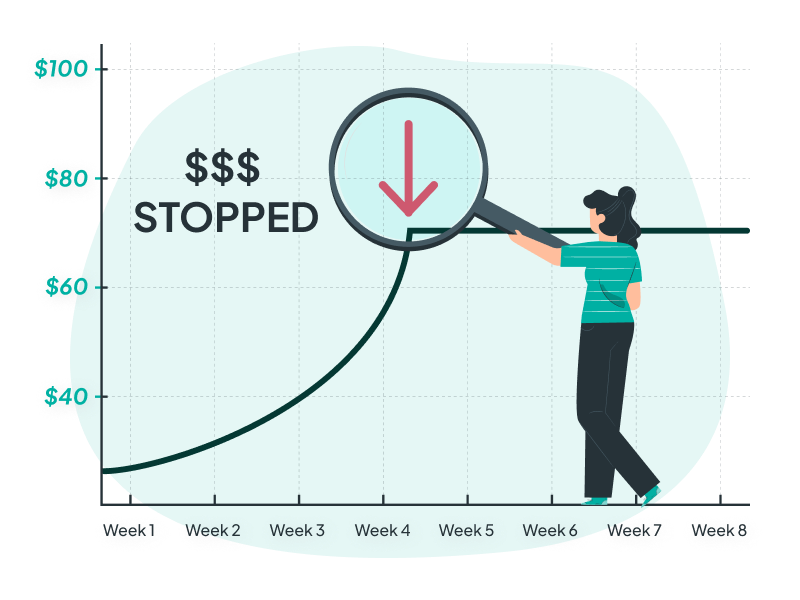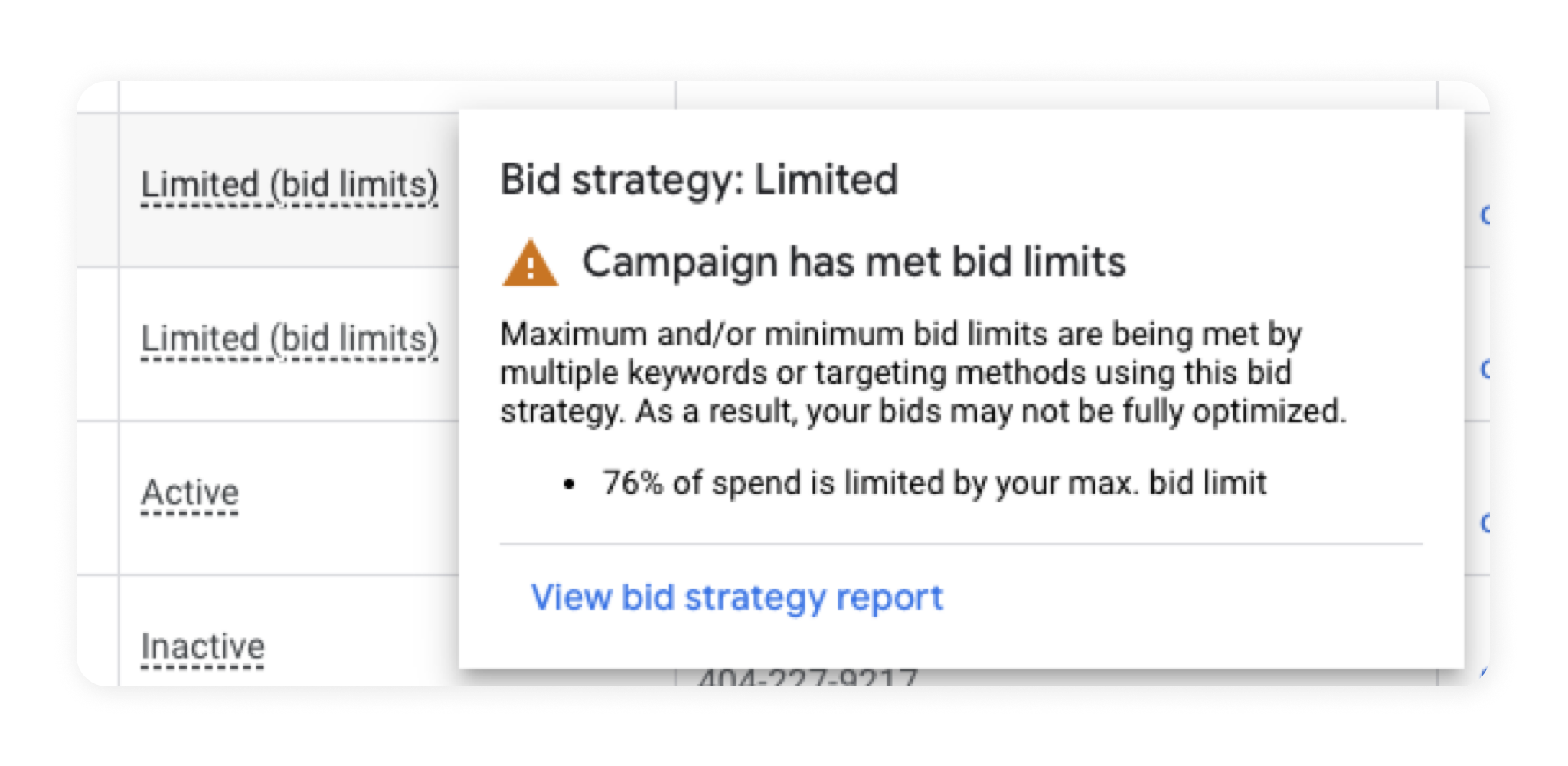Let’s be clear: Smart Bidding is one of the best things to come out of Google Ads in years, second only to Shopping ads. It does a much better job at managing bids at scale than any human ever could. But it has blind spots. There are things Smart Bidding simply doesn’t know, and if you let it run completely unchecked, it can lead to some truly wasteful spending.
That’s why I use max bid limits in every single Google Ads account I manage. Sometimes they’re aggressive, sometimes they’re lenient. I change them based on seasonality, promotions, and overall account performance. But the one constant is that I use them.
The trap almost everyone falls into is setting these limits way too aggressively in an attempt to save money. When you do that, you’re not just cutting costs; you’re quietly telling Smart Bidding to stop showing your ads to some of your best and most profitable customers. This is exactly how Google reps get the ammunition they need to tell you “don’t touch any settings, just let Smart Bidding work.”
I’m going to show you how to find the perfect balance to control your CPCs without strangling your campaign’s growth.
Go Beyond the Article
Why the Video is Better:
- See real examples from actual client accounts
- Get deeper insights that can’t fit in written format
- Learn advanced strategies for complex situations
Max vs. Min Bid Limits: A Crucial Distinction
Before we go any further, you need to understand the difference between the two types of bid limits. They might sound similar, but their impact on your account is drastically different.
The Maximum Bid Limit: A Hard Ceiling
The maximum bid limit is a straightforward command. You are telling Smart Bidding, “Under no circumstances should you bid higher than X for a single click.” It acts as a hard ceiling, preventing your cost-per-click from getting out of control.
It’s a direct, predictable way to control your upper-end costs. Crucially, it doesn’t have any complex algorithmic impact, and you can see the effect immediately. There’s no waiting period.
The Minimum Bid Limit: A Risky Floor
The minimum bid limit, on the other hand, is far more nuanced and carries significant risk. It attempts to establish a “bid floor” where you tell the system not to bid lower than a certain amount.
Here’s the problem: if Smart Bidding thinks it can’t achieve your ROAS target while bidding your specified minimum, it won’t just bid a little lower—it will pull you from the auction completely. The documentation doesn’t really describe this, but we’ve seen it time and again. We remove a minimum bid limit, and suddenly, we get more traffic. That’s odd, but telling.
This is the critical difference: a max bid limit simply shaves off the most expensive clicks, while a minimum bid limit can prevent you from bidding at all. Be very careful with minimum bid limits.
Four Ways I Use Max Bid Limits (From Least to Most Common)
I have a few core use cases for this feature, ranging from tactical exploration to essential performance management.
- To Correct Poor Performance (Most Common): This is my number one reason. Sometimes Smart Bidding doesn’t react fast enough, and we see week after week of missed ROAS targets. Instead of just waiting, I’ll take the edge off by setting a max bid limit at maybe 1.2x to 1.8x the average CPC. This trims the highest CPCs and helps us get back on target without having to make drastic changes to our strategy.
- For Basic Hygiene: Paying $20 for a click on a keyword that normally averages $2 is just wasteful. It makes no sense from an auction standpoint. I use max bid limits to prevent these absurd, outlier CPCs that can drain a budget with zero return.
- After a Big Sale: While seasonal bid adjustments are often my go-to for this, there are cases where a max bid limit just works better, especially if I don’t want to lower my bids across the board (more on this in a second).
- To Explore New Auctions (Least Common): This is a more advanced tactic. I’ll sometimes lower my ROAS target below our current performance but set a fairly low max bid limit (e.g., 1.5x average CPC). The goal is to encourage Smart Bidding to seek out new, cheaper auctions rather than just bidding up in our existing ones.
When to Use Max Bid Limits vs. Seasonal Bid Adjustments
I get this question a lot. Both can be used to decrease spend, but they work in fundamentally different ways.
A maximum bid limit tells the system it can’t bid higher than a specific amount. It has no impact on any bids below that limit.
A negative seasonal bid adjustment applies an equal percentage decrease to all auctions you participate in.
Imagine you have bids ranging from $8 down to $2. If you apply a max bid limit of $3.50, the $8, $5, and $4 bids are all capped at $3.50. The $3 and $2 bids are completely untouched.
Now, if you apply a -20% seasonal adjustment instead, every single bid is reduced. That $8 bid becomes $6.40, and—here’s the danger—that $2 bid becomes $1.60. If that 20% drop is enough to push you out of that cheaper auction entirely, you lose that traffic and the data that comes with it. A max bid limit would have left it alone.
There’s another counterintuitive part to seasonal adjustments: you are essentially telling Google to ignore the performance data from the period the adjustment is active. If you’re applying it because performance is low and you think this is the new normal, you might see a nasty spike the second the adjustment expires. Max bid limits can be much easier to manage in these scenarios.
“Limited by Bid Limit”: What This Warning Actually Means
A major client of ours was told by their Google rep that a “76% limited by bid limit” message meant they were being kept out of 76% of all possible auctions. That’s simply just not true.
What it actually means is that in 76% of the auctions you did participate in and win, Smart Bidding wanted to bid higher but was prevented by your limit. It does not mean you dropped out of 76% of auctions.
I have mountains of data showing that when we apply max bid limits, we do not see a corresponding drop in spend of 25%, 50%, or 76%. Don’t let this warning message scare you away from a valuable tool.
The Four Most Common (and Costly) Mistakes with Bid Limits
Max bid limits are a powerful lever, but if you pull it the wrong way, you can do some serious damage. Here are the mistakes I see most often.
Mistake #1: Being Way Too Aggressive
We ran a test where we grouped campaigns and applied different levels of bid limits. The “very aggressive” group had a limit set at 1x the average CPC. The initial results looked promising—profitability (POAS) improved by 15-30%. However, clicks dropped by 15%, and more importantly, conversions dropped by 33%.
We were getting locked out of the best auctions. After three months, the account entered a death spiral. Conversion volume kept falling, the back-end data looked worse, and eventually, total profit volume began to decline. An overly aggressive max bid can only be a temporary measure; otherwise, you’re headed for a downward spiral.
Mistake #2: Making Drastic, Jerky Adjustments
Max bid limits are not algorithmic. If you set a limit that’s too aggressive and your ROAS is way over target, the second you increase that limit, Smart Bidding will often jump its bids way up, close to your new ceiling. This creates a volatile seesaw of performance.
We saw this with a coaching client. Their ROAS would be way above target, so they’d increase the max bid limit too much, and performance would plummet. Then they’d overcorrect by dropping it too low, and ROAS would skyrocket again. The solution is to make slow, smooth changes to your limits or adjust your ROAS target as you go.
Mistake #3: Set It and Forget It
Your max bid limit is not a max CPC. It’s a ceiling for your bid. Market conditions change, and that ceiling needs to change with them. The most obvious example is Black Friday. Throughout the month, our average CPC might be 4-5 kroner, but during the sales event, it can skyrocket to 14 kroner. If we had left our standard 12 kroner max bid limit in place, we would have been completely capped out just when we needed to be most competitive.
Mistake #4: One Size Fits All
If you sell products with vastly different average order values (AOVs), a single bid limit can cause problems. If you sell high-AOV coats and low-AOV underwear, a single, account-wide limit might strangle your coat campaigns while having no impact at all on your underwear campaigns.
The solution is to split these products into different campaigns so you can apply different targets, budgets, and bid limits. We don’t do this all the time—it’s often an edge case for maybe 5% of accounts—but when it’s necessary, it’s critical for performance.
The Final Word: A Tool for the Top 20%
In 80% of cases, Smart Bidding does a pretty good job on its own. But to get to the next level—to squeeze out that last 5%, 10%, or 15% of performance—you need to know when to step in.
Max bid limits are the perfect tool to override Smart Bidding when it bids too high in those edge cases. Just be careful when you do it.
[TL;DR]
- Use Max, Not Min: Maximum bid limits safely cap high costs. Minimum bid limits are risky and can remove you from auctions entirely.
- Avoid the “Death Spiral”: Setting a max bid limit too aggressively (e.g., at 1x your average CPC) will kill your conversion volume over the long term, even if profitability looks good at first.
- Make Smooth Adjustments: Bid limits are not algorithmic. Avoid making large, sudden changes, as this will cause wild swings in performance. Adjust them gradually over time.
- Don’t “Set and Forget”: Your bid limits must adapt to market conditions. You’ll need higher limits during peak seasons like Black Friday and lower limits during downturns.
- One Size Does Not Fit All: Use different max bid limits for campaigns with vastly different product prices (AOV) to avoid strangling your high-value products.






